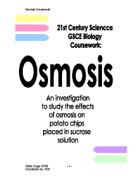To investigate the effect of varying concentration of a certain sugar solution on the amount of osmotic activity between the solution and a potato chip of a given size.
Biology Coursework 2003 Osmosis in Potatoes By Chantelle Wright 10 B PLANING Before actually planning the experiment, I will do some research to find out about osmosis, and matters related to it, so that I can make predictions. And figure out a way to make this investigation fair and safe. Planning ahead would help me find out how to do what and when, which should lead me to good results at the end of the experiment. Aim To investigate the effect of varying concentration of a certain sugar solution on the amount of osmotic activity between the solution and a potato chip of a given size. Background Knowledge Plant cells always have a strong cell wall surrounding them. When they take up water by osmosis they start to swell, but the cell wall prevents them from bursting. Plant cells become "turgid" when they are put in dilute solutions. Turgid means swollen and hard. The pressure inside the cell rises and eventually the internal pressure of the cell is so high that no more water can enter the cell. This liquid or hydrostatic pressure works against osmosis. Turgidity is very important to plants because this is what makes the green parts of the plant "stand up" into the sunlight. When plant cells are placed in concentrated sugar solutions they lose water by osmosis and they become "flaccid." This is the exact opposite of "turgid". The content of the potato cells shrinks
To investigate the effect of varying concentration of a certain sugar solution on the amount of osmotic activity between the solution and a potato chip of a given size.
Title: Investigating osmosis in potatoes Aim: To investigate the effect of varying concentration of a certain sugar solution on the amount of osmotic activity between the solution and a potato chip of a given size. Back Ground Information: Osmosis, transfer of a liquid solvent through a semi permeable membrane that does not allow dissolved solids (solutes) to pass. Osmosis refers only to transfer of solvent; transfer of solute is called dialysis. In either case the direction of transfer is from the area of higher concentration of the material transferred to the area of lower concentration. This spontaneous migration of a material from a region of higher concentration to a region of lower concentration is called diffusion. Plasmolysis is the separation of plant cell cytoplasm from the cell wall as a result of water loss. As moisture leaves the vacuole the total volume of the cytoplasm decreases while the cell itself, being rigid, hardly changes. Plasmolysis is unlikely to occur in the wild except in severe conditions. Plasmolysis is induced in the laboratory by immersing a plant cell in a strongly saline or sugary solution, so that water is lost or gained by osmosis. Further information on potato plant cells: Plant cells always have a strong cell wall surrounding them. When they take up water by osmosis they start to swell, but the cell wall prevents them from



















